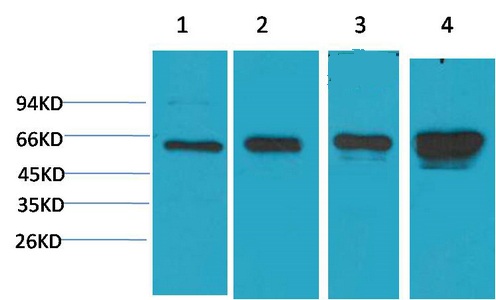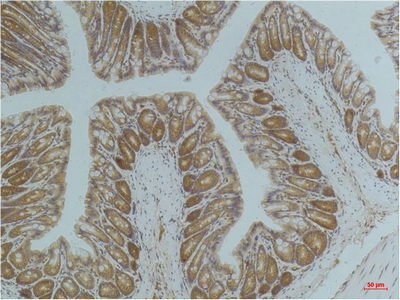AMPK α1 Monoclonal Antibody(5G11)
- Catalog No.:YM3520
- Applications:WB;IHC;IF
- Reactivity:Human
- Target:
- AMPKα1
- Fields:
- >>FoxO signaling pathway;>>Autophagy - animal;>>mTOR signaling pathway;>>PI3K-Akt signaling pathway;>>AMPK signaling pathway;>>Longevity regulating pathway;>>Longevity regulating pathway - multiple species;>>Apelin signaling pathway;>>Tight junction;>>Circadian rhythm;>>Thermogenesis;>>Insulin signaling pathway;>>Adipocytokine signaling pathway;>>Oxytocin signaling pathway;>>Glucagon signaling pathway;>>Insulin resistance;>>Non-alcoholic fatty liver disease;>>Alcoholic liver disease;>>Hypertrophic cardiomyopathy;>>Fluid shear stress and atherosclerosis
- Gene Name:
- PRKAA1
- Protein Name:
- 5'-AMP-activated protein kinase catalytic subunit alpha-1 (AMPK subunit alpha-1) (EC 2.7.11.1) (Acetyl-CoA carboxylase kinase) (ACACA kinase) (EC 2.7.11.27) (Hydroxymethylglutaryl-CoA reductase kinase
- Human Gene Id:
- 5562
- Human Swiss Prot No:
- Q13131
- Mouse Swiss Prot No:
- Q5EG47
- Rat Swiss Prot No:
- P54645
- Immunogen:
- Synthetic Peptide of AMPK α1
- Specificity:
- AMPK α1 protein detects endogenous levels of AMPK α1
- Formulation:
- Liquid in PBS containing 50% glycerol, 0.5% BSA and 0.02% sodium azide.
- Source:
- Monoclonal, Mouse
- Dilution:
- WB 1:1000-2000, IHC 1:50-100. IF 1:50-200
- Purification:
- The antibody was affinity-purified from mouse ascites by affinity-chromatography using specific immunogen.
- Concentration:
- 1 mg/ml
- Storage Stability:
- -15°C to -25°C/1 year(Do not lower than -25°C)
- Other Name:
- PRKAA1;AMPK1;5'-AMP-activated protein kinase catalytic subunit alpha-1;AMPK subunit alpha-1;Acetyl-CoA carboxylase kinase;ACACA kinase;Hydroxymethylglutaryl-CoA reductase kinase;HMGCR kinase;Tau-protein kinase PRKAA1
- Observed Band(KD):
- 63kD
- Background:
- The protein encoded by this gene belongs to the ser/thr protein kinase family. It is the catalytic subunit of the 5'-prime-AMP-activated protein kinase (AMPK). AMPK is a cellular energy sensor conserved in all eukaryotic cells. The kinase activity of AMPK is activated by the stimuli that increase the cellular AMP/ATP ratio. AMPK regulates the activities of a number of key metabolic enzymes through phosphorylation. It protects cells from stresses that cause ATP depletion by switching off ATP-consuming biosynthetic pathways. Alternatively spliced transcript variants encoding distinct isoforms have been observed. [provided by RefSeq, Jul 2008],
- Function:
- catalytic activity:ATP + a protein = ADP + a phosphoprotein.,cofactor:Magnesium.,enzyme regulation:Binding of AMP results in allosteric activation, inducing phosphorylation on Thr-174 by STK11 in complex with STE20-related adapter-alpha (STRAD alpha) pseudo kinase and CAB39. Also activated by phosphorylation by CAMKK2 triggered by a rise in intracellular calcium ions, without detectable changes in the AMP/ATP ratio.,function:Responsible for the regulation of fatty acid synthesis by phosphorylation of acetyl-CoA carboxylase. It also regulates cholesterol synthesis via phosphorylation and inactivation of hormone-sensitive lipase and hydroxymethylglutaryl-CoA reductase. Appears to act as a metabolic stress-sensing protein kinase switching off biosynthetic pathways when cellular ATP levels are depleted and when 5'-AMP rises in response to fuel limitation and/or hypoxia. This is a catalytic s
- Subcellular Location:
- Cytoplasm . Nucleus . In response to stress, recruited by p53/TP53 to specific promoters. .
- Expression:
- Brain,Intestine,Liver,Mammary gland,Platelet,Testis
PM2.5 induces autophagy-mediated cell death via NOS2 signaling in human bronchial epithelium cells. International Journal of Biological Sciences Int J Biol Sci. 2018; 14(5): 557–564 WB Human BEASE-2B cell
PM2.5 induces autophagy-mediated cell death via NOS2 signaling in human bronchial epithelium cells. International Journal of Biological Sciences Int J Biol Sci. 2018; 14(5): 557–564 WB Human BEASE-2B cell
- June 19-2018
- WESTERN IMMUNOBLOTTING PROTOCOL
- June 19-2018
- IMMUNOHISTOCHEMISTRY-PARAFFIN PROTOCOL
- June 19-2018
- IMMUNOFLUORESCENCE PROTOCOL
- September 08-2020
- FLOW-CYTOMEYRT-PROTOCOL
- May 20-2022
- Cell-Based ELISA│解您多样本WB检测之困扰
- July 13-2018
- CELL-BASED-ELISA-PROTOCOL-FOR-ACETYL-PROTEIN
- July 13-2018
- CELL-BASED-ELISA-PROTOCOL-FOR-PHOSPHO-PROTEIN
- July 13-2018
- Antibody-FAQs
- Products Images

- Western blot analysis of 1)Hela, 2) 293T, 3)3T3, 4) PC12 with AMPK a1 Mouse mAb diluted at 1:2,000.

- Immunohistochemical analysis of paraffin-embedded Mouse ColonTissue using AMPK a1 Mouse mAb diluted at 1:200.



